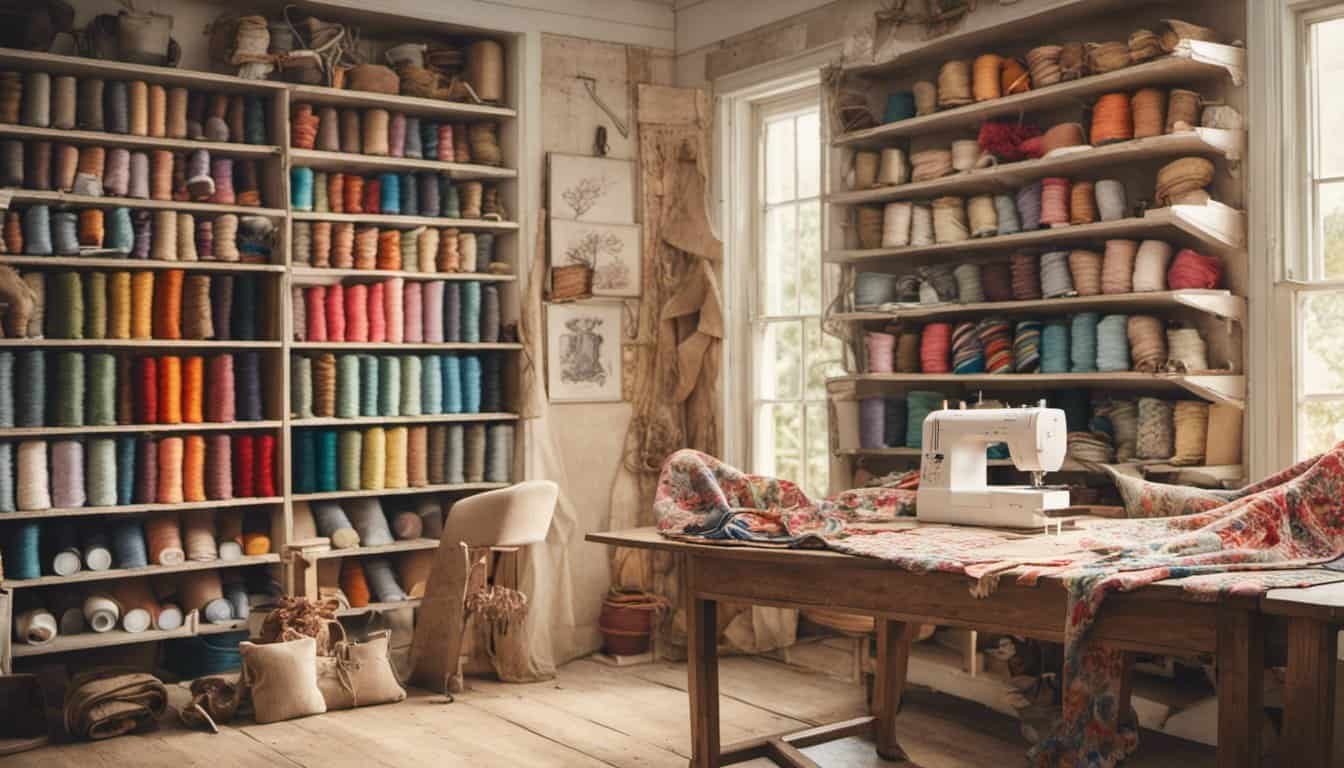I’ve always loved the idea of combining practicality with creativity, and sewing a fabric placemat with pockets is the perfect project for that. It’s not just a functional addition to your dining table; it’s also a charming way to add a personal touch to mealtime. Whether you’re hosting guests or just sprucing up your everyday setup, these pocketed placemats are both stylish and useful.
Materials Needed For Sewing A Fabric Placemat With Pockets
Having the right materials ensures a smooth sewing process and enhances the placemat’s durability and appearance. Here’s what I use for this project:
- Fabric: Two coordinating cotton fabrics (one for the main placemat and one for the pockets). Each fabric should measure at least 14″x20″ for a standard placemat size.
- Interfacing: Lightweight fusible interfacing adds structure to the placemat and prevents sagging.
- Thread: Cotton or polyester thread matching the fabric colors ensures neat, durable seams.
- Scissors or Rotary Cutter: Sharp fabric scissors or a rotary cutter for clean fabric cuts.
- Measuring Tools: A ruler or measuring tape for precise dimensions. Quilting rulers can help with straight edges.
- Iron and Ironing Board: Essential for pressing seams, adhering interfacing, and achieving a polished look.
- Pins or Clips: Keep fabric layers aligned while stitching.
- Sewing Machine: A basic machine with a straight stitch function works well for this project.
- Marking Tools: Water-soluble fabric markers or chalk help mark pocket placements without residue.
- Optional Decorations: Lace, bias tape, or embroidery can personalize the placemat further.
Using high-quality materials results in a durable, aesthetically pleasing placemat with pockets. Every component, from fabric choice to stitching tools, plays a role in crafting this functional design.
Step-By-Step Guide To Sewing The Placemat
Sewing a fabric placemat with pockets combines practical functionality with creative flair. Follow these steps for a polished, handmade placemat that’s durable and decorative.
Cutting And Preparing The Fabric
Start by cutting two rectangles from your main fabric, each measuring 14 x 18 inches. If using a different size, ensure both pieces are identical. Cut a similarly sized piece of lightweight fusible interfacing for added structure.
Cut 2-3 smaller rectangles, depending on the number of pockets you want, ensuring they fit along one edge of the placemat. For example, 5 x 6 inches works well for utensils. Press all fabric pieces to remove creases. Fuse the interfacing to the wrong side of one main fabric rectangle using an iron on a low setting.
Adding The Pockets
Fold the top edge of each pocket rectangle over by 0.5 inches, wrong side in, then press and stitch a straight seam close to the folded edge. Position the pockets on the right side of the interfaced rectangle, spaced evenly or aligned as preferred, and pin them in place.
Secure the sides and bottom edges of each pocket by sewing close to the raw edges. For durability, backstitch at the upper pocket corners where stress is higher.
Sewing The Placemat Edges
Place the two main fabric rectangles right sides together. Pin around all edges, leaving a 3-4 inch gap on one side for turning. Sew around the perimeter with a 0.5-inch seam allowance.
Clip the corners at an angle to reduce bulk before turning the placemat right side out. Use a turning tool or blunt object like a chopstick to push out corners neatly. Press the placemat flat, ensuring all edges are smooth.
Finishing Touches And Decorations
Topstitch around the entire placemat 0.25 inches from the edge, closing the turning gap and reinforcing the shape. Increase decorative appeal by using contrasting thread or adding a decorative stitch pattern.
For extra flair, consider embellishments like embroidered monograms, appliqué designs, or decorative buttons on the pockets. Add these sparingly to maintain balance and practicality.
Tips For Choosing The Right Fabric And Tools
Selecting suitable fabric and tools is crucial for sewing fabric placemats with pockets. The right choices ensure precision and enhance the durability and appearance of your project.
Fabric Selection
- Choose cotton for versatility: Cotton fabrics, like quilting cotton, offer durability and come in various patterns and colors, making them ideal for placemats.
- Pick coordinating prints: Using complementary patterns or colors for the main fabric and pocket pieces creates visual harmony. For example, pair a solid color with a subtle floral print.
- Ensure washability: Select pre-shrunk, washable fabrics to maintain placemats’ shape and color after regular cleaning.
- Consider interfacing types: Lightweight fusible interfacing adds structure without making the placemat overly stiff.
Essential Tools
- Use sharp fabric scissors: Quality scissors make cutting fabric rectangles and pocket pieces more precise.
- Select matching thread: Coordinating thread blends better with fabric and enhances the finished look.
- Utilize a rotary cutter: A rotary cutter speeds up cutting straight edges and ensures clean, accurate lines, especially when paired with a cutting mat.
- Grab clips over pins: Fabric clips prevent puncturing delicate fabrics while holding layers together securely during assembly.
- Prepare a pressing tool: Using an iron helps achieve crisp seams and folds for professional results.
Making thoughtful fabric and tool choices simplifies the sewing process and ensures a polished, functional placemat.

Benefits Of Using A Fabric Placemat With Pockets
Using a fabric placemat with pockets offers practical and aesthetic advantages. It provides an organized dining experience by keeping utensils, napkins, or small condiments neatly in place. This reduces table clutter and ensures essentials are within easy reach.
The pockets enhance functionality, making the placemat versatile for different mealtime settings. For example, they’re ideal for casual family dinners, outdoor picnics, or formal gatherings where a tidy presentation matters. Having dedicated storage in the placemat simplifies serving and cleanup.
Fabric placemats with pockets also add a personal touch to the dining table. By selecting designs and fabrics that match the theme or occasion, you can tie in decor elements creatively. For instance, holiday-themed prints or elegant patterns create a cohesive and inviting look.
They’re reusable and washable, offering a sustainable alternative to disposable tableware. Machine-washable cotton fabrics are durable, maintain their finish, and withstand frequent laundering, ensuring long-lasting usability.
Creative Ideas To Personalize Your Placemat
Adding unique touches makes your placemat stand out. Here are several ideas to personalize your project:
- Embroidery Details
« How to Sew a Fabric Pen Holder: Easy DIY Tutorial for Beginners and Craft Lovers
Master Sewing a Wrap Dress: Step-by-Step Guide for Beginners to Create a Perfect Fit »
Stitch initials, monograms, or custom designs onto the fabric. For example, embroider floral patterns on the corners or a family name above the pocket for a tailored finish.
- Patchwork Patterns
Combine different fabric scraps for a patchwork design. Use complementary colors or themes, like seasonal prints for holidays or geometric patterns for a modern look.
- Decorative Pockets
Use contrasting fabrics, lace trims, or appliqués for the pockets. For instance, sew a pocket with printed fabric and add a lace edge for visual appeal.
- Fabric Paint or Stamps
Add painted designs or stamped patterns to plain fabric. For example, hand-paint abstract designs with cross-hatched patterns or use stamps with styled motifs, like leaves or stars.
- Trim and Edging Accents
Sew on decorative trims or bias tape along the edges. Consider pom-poms for a playful style or metallic piping for an elegant touch.

- Themed Accessories
Match pocket designs with a dining theme. For instance, pair nautical pocket prints with coordinating tableware or seasonal tones for a festive setup.
- Personalized Tags
Attach a fabric or leather tag with stitched messages. Include words like “Handmade with Love” or initials to highlight the handmade value.
Incorporating these elements enhances both functionality and visual appeal, creating placemats that reflect your creativity and suit various dining occasions.
Conclusion
Sewing fabric placemats with pockets is such a rewarding way to combine practicality with a personal touch. Whether you’re sprucing up your dining table or crafting a thoughtful gift, this project is a wonderful opportunity to let your creativity shine.
By using quality materials and adding your own unique details, you’ll create placemats that are not only functional but also full of charm. Plus, knowing they’re reusable and sustainable makes them even more special.

I hope this inspires you to grab your sewing tools and start stitching something beautiful for your table. Happy sewing!

















